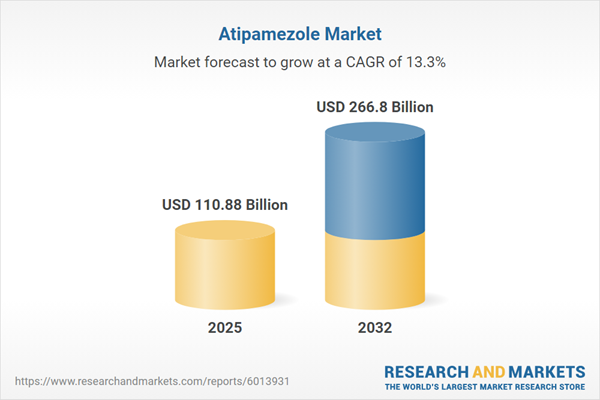Speak directly to the analyst to clarify any post sales queries you may have.
As veterinary care environments evolve, senior decision-makers face increased complexity around care quality and operational efficiency. The atipamezole market provides a proven solution for sedation reversal, supporting clinical protocols and pharmaceutical progress across animal health systems.
Atipamezole Market Snapshot
The global atipamezole market is experiencing rapid development, underpinned by continuous innovation within veterinary pharmaceuticals and a surge in new product introductions. With the market size reaching USD 98.03 billion in 2024 and projected growth to USD 110.88 billion by 2025, the segment demonstrates a strong compound annual growth rate of 13.33%. Momentum is anticipated to extend, positioning the sector toward an estimated USD 266.80 billion by 2032. Driving this trajectory are broader adoption in animal health settings, enhanced supply channels, and evolving approaches that focus on optimizing both practitioner productivity and patient outcomes. Together, these elements are raising the quality benchmarks and efficiency of veterinary medicine worldwide.
Scope & Segmentation within the Atipamezole Market
Strategic segmentation offers a comprehensive overview that enables senior leaders to identify growth opportunities and streamline resource deployment, especially as technology adoption and global market dynamics continue to reshape the sector.
- Animal Types: Solutions tailored for cats, dogs, and horses contribute to dosing accuracy and extend safety protocols into both routine and specialized animal care workflows.
- Product Forms: Prefilled syringes and vials are designed for streamlined administration, supporting not only routine treatments but also emergency and advanced veterinary procedures where efficiency and accuracy are critical.
- Administration Routes: Intramuscular and intravenous pathways offer flexibility in patient management, adapting to variable clinical requirements and allowing practitioners to optimize therapeutic impact.
- End Users: Veterinary clinics, animal hospitals, and research institutes each feature unique adoption patterns, directly impacting procurement cycles and differentiation in innovation outcomes.
- Distribution Channels: Direct sales, retail and online pharmacies, and specialist veterinary distributors work together to strengthen supply chain resilience and facilitate broader access for practitioners.
- Regions: Americas, Europe, Middle East, Africa, and Asia-Pacific each have distinct regulatory frameworks and market conditions, necessitating localized go-to-market strategies and the formation of region-specific partnerships.
- Technology Integration: Digital tools and workflow platforms are supporting dosing precision, compliance, and adaptability—driving improvements in both established and emerging veterinary markets.
By focusing on clearly defined segments and leveraging advanced digital platforms, organizations can respond rapidly to new regulatory requirements, shifts in market demand, and changes in operational environments across geographic regions.
Key Takeaways: Atipamezole Market Strategic Insights
- Refinement of sedation reversal protocols is supporting improved patient safety, giving clinicians the tools for high-quality and repeatable outcomes in daily practice.
- Developments in formulations and advanced delivery systems are meeting the evolving efficiency needs within diverse veterinary care settings and networks.
- Adhering to changing compliance landscapes requires organizations to maintain flexible planning cycles and vigilant market entry strategies, securing long-term adaptability.
- Real-time validation tools are enhancing evidence-based decisions, increasing trust levels among leadership, partners, and stakeholders throughout the value chain.
- Expansion of digital monitoring and automation streamlines workflow and increases decision-making capacity by offering actionable data to senior managers.
- Partnerships among manufacturers, distributors, and technology providers are building resilient supply chains and improved responsiveness as market and operational pressures shift.
Tariff Impact on Atipamezole Supply Chain in the United States
Recent changes in tariffs have heightened complexity around sourcing raw materials for atipamezole in the U.S. manufacturing landscape. In response, manufacturers are reinforcing domestic sourcing networks and forging new alliances to better manage operational risks. Veterinary clinics and distributors are advised to review inventory management and procurement frameworks to build resilience. At the same time, the integration of sustainable processes, advanced demand prediction, and adaptable pricing strategies is contributing to the industry’s competitive posture as regulatory and market forces evolve.
Methodology & Data Sources
This market research report relies on a rigorous, multi-source approach, combining direct engagement with industry practitioners and regulators. Extensive secondary research draws from regulatory filings and authoritative peer-reviewed publications to ensure precision and validate key market trends and findings.
Why This Report Matters
- Enables senior executives to prioritize investment and resource strategies through accessible, actionable insights tailored to specific market developments.
- Positions leadership to address dynamic regulatory challenges, evolving procurement channels, and strategic partnership opportunities with readiness and foresight.
- Identifies segments and dynamics primed for growth, facilitating resilient responses as animal healthcare environments transform.
Conclusion
Ongoing advancements in regulation, digital platforms, and clinical development are shaping the evolution of the atipamezole market. Data-driven insights empower leaders to foster impactful innovation and sustain high standards in veterinary care.
Additional Product Information:
- Purchase of this report includes 1 year online access with quarterly updates.
- This report can be updated on request. Please contact our Customer Experience team using the Ask a Question widget on our website.
Table of Contents
3. Executive Summary
4. Market Overview
7. Cumulative Impact of Artificial Intelligence 2025
Companies Mentioned
The companies profiled in this Atipamezole market report include:- Orion Corporation
- Zoetis Inc.
- Elanco Animal Health Inc.
- Merck & Co., Inc.
- Boehringer Ingelheim International GmbH
- Dechra Pharmaceuticals plc
- Vetoquinol SA
- Ceva Santé Animale S.A.
- Virbac S.A.
- Qilu Animal Health Products Co., Ltd.
Table Information
| Report Attribute | Details |
|---|---|
| No. of Pages | 198 |
| Published | October 2025 |
| Forecast Period | 2025 - 2032 |
| Estimated Market Value ( USD | $ 110.88 Billion |
| Forecasted Market Value ( USD | $ 266.8 Billion |
| Compound Annual Growth Rate | 13.3% |
| Regions Covered | Global |
| No. of Companies Mentioned | 11 |









